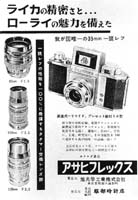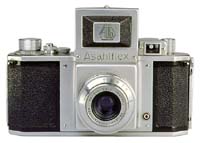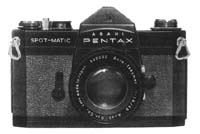Eighty years of Pentax history in six pages
Back in the 1960’s an advertising slogan for Pentax simply said "just hold a Pentax". That single statement really said it all. The cameras produced at that time by Asahi Optical Co. were small and functional, with smoothly operating controls. The body design was clean and simple, with no fancy frills. As soon as you picked one up and held it in your hand, you knew that here was a precision instrument capable of producing the highest quality results. In fact, a design concept that was, with the passage of time, destined to become a classic in its own right.
Although Asahi Optical Co. Ltd is noted for producing Pentax cameras and lenses, it did not, in fact produce a camera of its own until some thirty-two years after it was founded. The company was originally called ‘Asahi Kogaku Goshi Kaisha’, and it was established in November 1919, by Kumao Kajiwara, at shop premises in a suburb of Tokyo, called Toshima, in order to produce spectacle lenses, which it still does to this very day.
In 1923 the company began to manufacture lenses for cine projectors for another maker. The following years saw further development of the lens making side of the business and, in 1932, Asahi commenced to make lenses for the Molta Camera Company, now Minolta, for a 6.5cms x 9cms folding plate camera, called the ‘Arcadia’. The following year, 1933, they began to supply Konishiroku, now Konica, with a range of single element and anastigmat lenses for their Pearl and Pearlette series of cameras.
In 1938 the old company changed its name to Asahi Optical Company Limited. At that time it undertook government contracts to produce optical instruments, which it continued to do so up until the end of World War II.
On returning to peacetime production Asahi Optical began to make lenses for many other Japanese camera manufacturers. At this time coating began to be applied to all lenses. In 1948 Asahi developed a range of miniature binoculars under the trade name ‘Jupiter’, these also incorporated coated optics which provide unparalleled clarity and contrast, putting them in the front line of technology at that time.
During the Korean War, popularity of Japanese cameras soared, in particular coupled rangefinder models from both Canon and Nikon, which were based on German Leica and Contax models. As these models steadily gained acceptance, the then President of Asahi Optical Company, Saburo Matsumoto, began to explore the possibility of the company producing its own camera, which was to be like no other model manufactured in Japan at that time.
The Asahi designers commenced research and development in 1950 on the project and, a year later, in late 1951, a prototype 35mm single lens reflexreflex
Cameras equipped with a targeting system that allows you to see through the viewfinder the framing that lens collects and reproduces the image on the sensing element (film or sensor). camera was ready. This camera was based on the German ‘Praktiflex’ design and was fitted with a waist-level viewfinder and a mirror which rose when the shutter button was pressed. The mirror fell to its viewing position when pressure was released. The mirror could be swung up and down whether or not the shutter was tensioned. The ground glass screen provided a bright image the correct way up, but reversed from left to right. This arrangement was acceptable for horizontal shots, but focusing vertical picture was almost impossible to achieve. For this reason, a small optical viewfinder was positioned to the left of the waist-level one. After further modifications and refinements, the new camera, called the ‘Asahiflex’ was put on sale on the Japanese home market in May 1952. The range of lenses introduced with the camera were called ‘Takumar’, after Takuma Kajiwara, a relative of both the founder, Kumao Kajiwara and the company President, Saburo Matsumoto. Takuma Kajiwara had gone to America around 1900 and had made his way as a photographer. He was also reported to be associate of George Eastman, the founder of ‘Kodak’.
The Asahiflex was the first Japanese 35mm single lens reflex camera to be produced and as such, can claim to be the father of this oriental breed of model type. Other manufacturers quickly saw the potential of reflex viewing though the taking lens and began to develop their own ranges.

Asahiflex advert in old Japanese magazine
The biggest drawback to the concept was the fact that the image blacked out when the mirror rose, and that the aperture had to be set manually, thereby giving a very dark image on the focusing screen. By 1953 the Takumar lenses were fitted with a pre-set aperture ring which allowed focusing to be done at full aperture. A second free running ring behind this aperture ring permitted the selected aperture to be closed down without removing the camera from the eye.
The following year saw a major breakthrough in design on the Asahiflex IIB. The problem of lens blackout had been overcome by the introduction of the instant return mirror, which returned the mirror to viewing position under spring pressure as soon as the shutter had fired. It is true that quick-return mirror had been used in a Hungarian camera made in 1947, called ‘Duflex’, but the system was unreliable and very few cameras were made. Asahi, therefore, can righty claim that they were the first manufacturers to incorporate a successful instant return mirror into a massed produced camera.
After the introduction of the instant return mirror, camera development really took off, and in 1957 Asahi Optical Co. scored another success by introducing the Pentax, which incorporated a built-in pentaprism giving a bright focusing screen image, which was the correct way up and unreversed. This model was the first Japanese SLRSLR
Acronym of "Single Lens Reflex". See also "Reflex" to incorporate a pentaprism system and as such heralded the dawn of a new photographic era. The days of the rangefinder camera were numbered.
Further developments and refinements took place in SLR models from all of the major manufacturers, including the introduction of built-in exposure meters. Asahi Optical had developed a clip-on CdS exposure meter which sat atop of the pentaprism and coupled to the shutter speed dial of Pentax models S1a and SV. The earlier models S1, S2 and S3 could be updated to take the exposure meter by a simple replacement of the shutter speed dial with a notched one, which could be done by the user in about one minute.
The next breakthrough came in 1960, when Asahi Optical showed a prototype camera at Photokina, which took exposure measurements through the taking lens. The camera was called the Spot-Matic and caused a sensation at the show. With the standard 50mm lens fitted to the camera the exposure meter took a central 3 degree reading from the focusing screen of the in focus subject. However, with their reputation for not introducing any development onto the market until it had been fully tried and tested under all possible conditions, the much changed, and slightly renamed Spotmatic, was not put on sale until almost four years later in early 1964. The redesigned camera now sported an all over average reading exposure meter, which gave more consistent results than that of the early spot version. The camera was an instant success and was snapped up by the thousand. Although Asahi had invented the TTLTTL
acronym of "Through The Lens" metering system, another manufacturer, Topcon, with the RE Super, went on sale in April 1963. The Topcon featured a semi-silvered mirror with the metering cell on the back of it.
In 1966 Asahi Optical had produced one million SLR cameras since the first Asahiflex of 1952. It took them another three years, until 1969 to reach two million, such was the popularity of the Pentax.
Also in 1969 a radical change of direction took place, when the professional Pentax 6X7 was introduced. This new model looked like a king sized 35mm SLR, and handled almost just as easily. It could accept either 120 rollfilm or 220 rollfilm, and was an overnight success, so much so that its derivative 67II is still in production today, a production run of over thirty years!
In 1975 another important change took place in the development of Pentax camera design. For several years, Asahi had been aware of the limitations put on further progress by retaining the 42mm screw thread lens mount. By this time most other manufacturers had opted for the bayonet lens mount in one form or another. It was a giant step for Asahi to take as they wanted to keep faith with the many thousands of satisfied users the world over who had been building up outfits based on the screw mount for years. The 42mm universal screw mount had reached the end of its useful life with the Pentax Spotmatic F and ESII models.
No less than three new models were introduced at once in 1975. They were based on the Spotmatic F and ESII models, and all featured a new, wider lens mount designated K-bayonet. all earlier lenses and attachments, such as bellows units etc. could be used on the new bodies by means of an adaptor ring. However, all lens automation was lost when the adaptor was used. The new models were called KM, KX and K2.
During 1978 another first was achieved by the introduction of the Pentax 110 system, which was designed around the then popular 110 film cartridge, introduced by Kodak. This Pentax was the only 110 camera from any manufacturer which took fully interchangeable lenses. Again, this camera was an overnight success when shown at that year’s Photokina. Today it is sought after both by users and collectors, as is its updated sister the Auto 110 Super, which was introduced in 1982.
During 1976 the Pentax M-Series was introduced to the photographic public. the first two models being the ME and MX. The trend towards smaller and lighter cameras had been started by Olympus with their OM1 model. the challenge was met by Pentax with these two new models, by which the ME could be considered a simplified version of the K2, with the MX being directly related to the KX.
The two new models were much smaller and lighter than the K series, which they replaced, and had more of the appeal of the original S series. The M series was developed over a period of several years, culminating with the professional LX model of 1980 (LX being the Roman numerals for sixty to celebrate Asahi Optical Co’s sixtieth anniversary the previous year), and the ME-F model of 1981, which was the world’s first TTL autofocus SLR camera. Also during 1981 production reached the staggering figure of ten million SLR cameras since 1952.
In the fifty years that Asahi Optical Co. have been making cameras, they have produced about two hundred different models of single lens reflexes and compact cameras, including specialised types, catering for all photographers from professionals to absolute beginners. They have been the pioneering force behind many of the developments that today we take for granted, and quite rightly, are amongst the top five manufacturers. Their products have always been in great demand, both to use and to collect, and in some respects are timeless, as can be shown in the Pentax K1000. This basic manual model was introduced in 1975 and has been many a person’s introduction to the fascinating world of photography. It was in production for almost twenty-five years and has sold about three million units! The largest production run in history and the second longest only to the Pentax 6X7.
Over the years Pentax have always kept faith with the buying public and have never indulged in planned obsolescence. Indeed, lenses from the very first Asahiflex of 1952 can still be fitted to and used successfully, via adaptors, on their latest autofocus SLRs. No other manufacturer today can make that claim.
The original article was published on SPOTMATIC magazine #32, April 2002.
- K-3 III Monochrome
2024-03-03
- 25° Pentax Day at ARENZANO il 5 maggio !
2024-03-03
- 24° PENTAX-DAY at PARMA on 25 June!
2023-06-19
Articles | About us | Pentax Day |
Vintage pictures | Batteries | Info Post |
Magazine | Books | Prototypes |
FAQ | Reflex | Screw M. Lenses |
Catalog | Search | CD-ROM |
Pentax Star System |
C.F.: 92085200399
Visite: 5450










